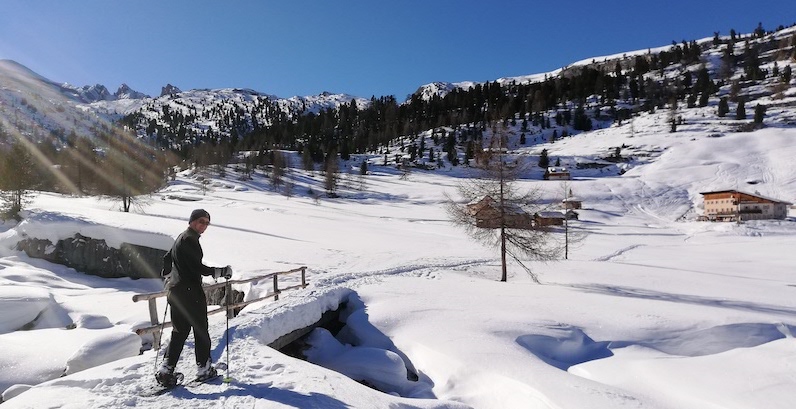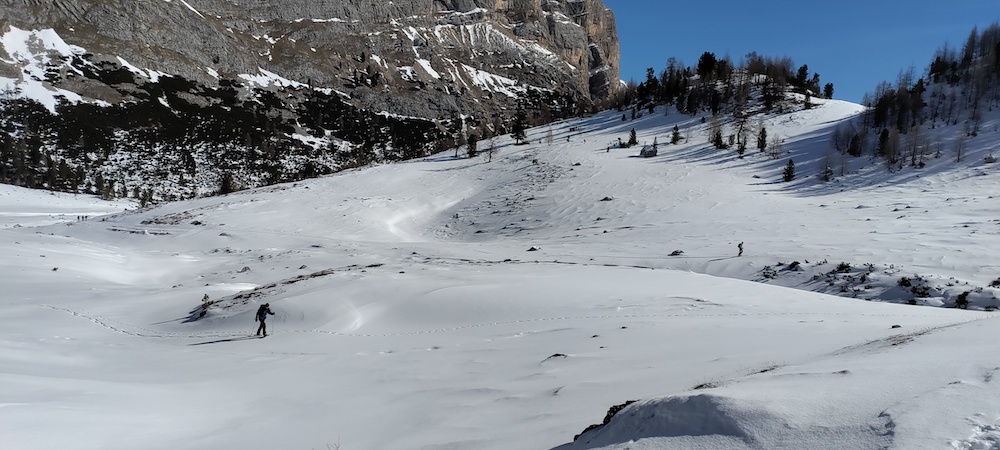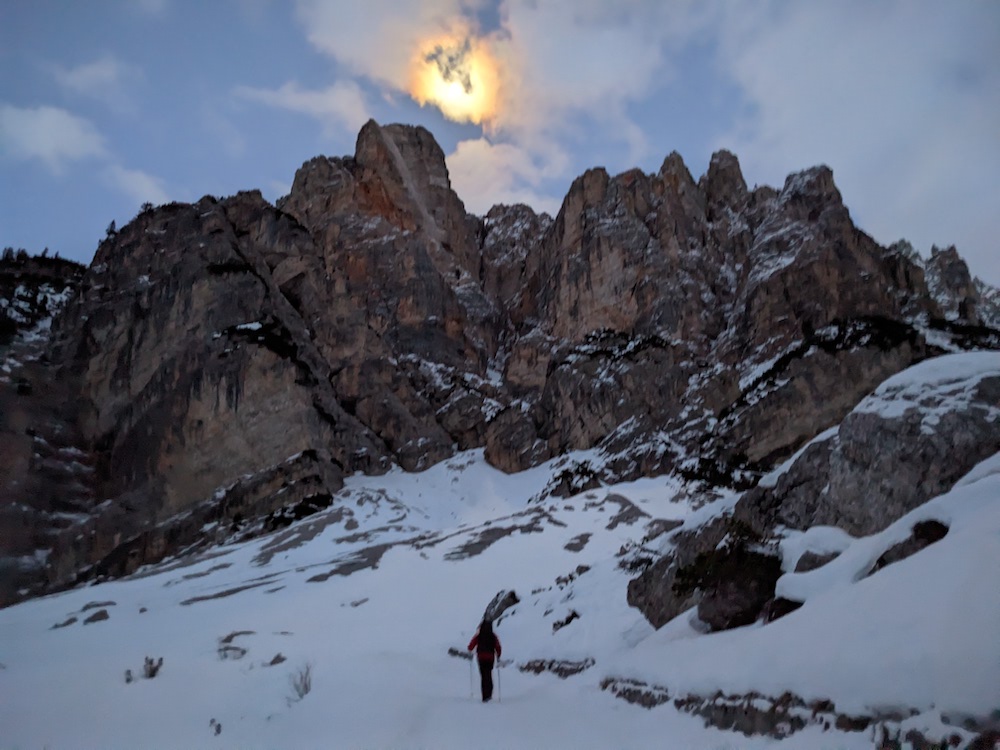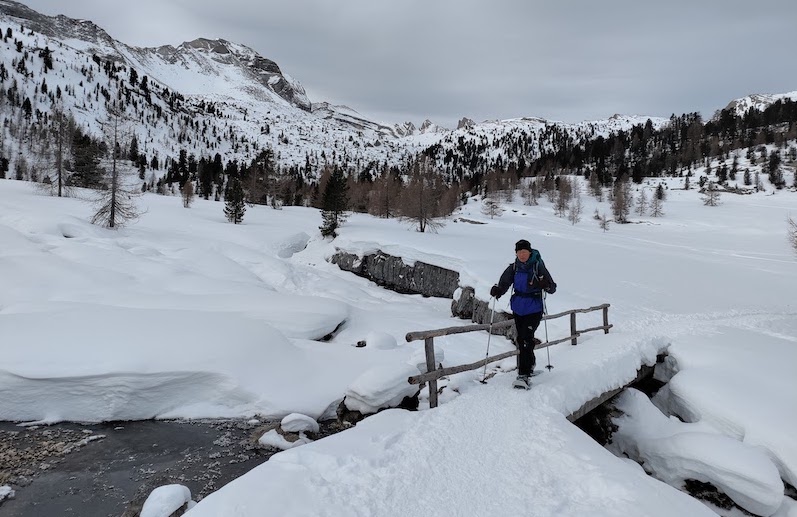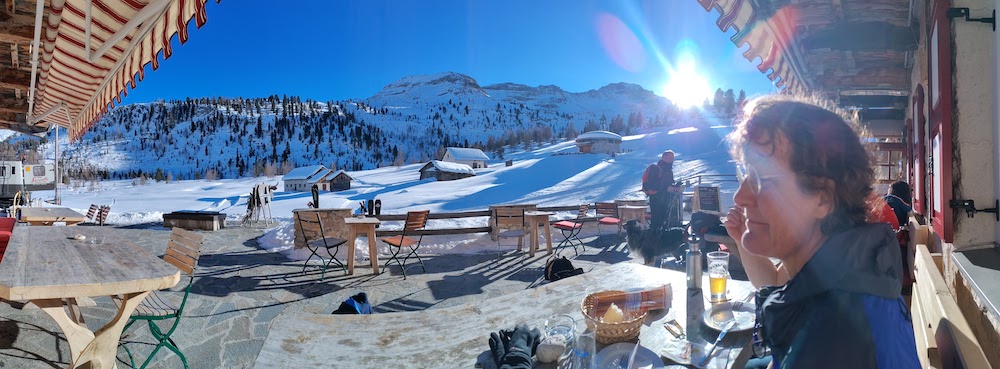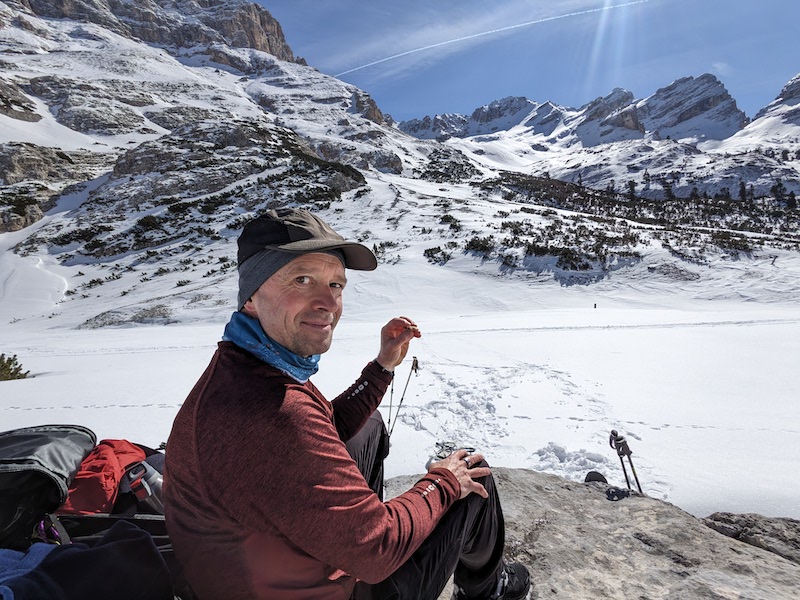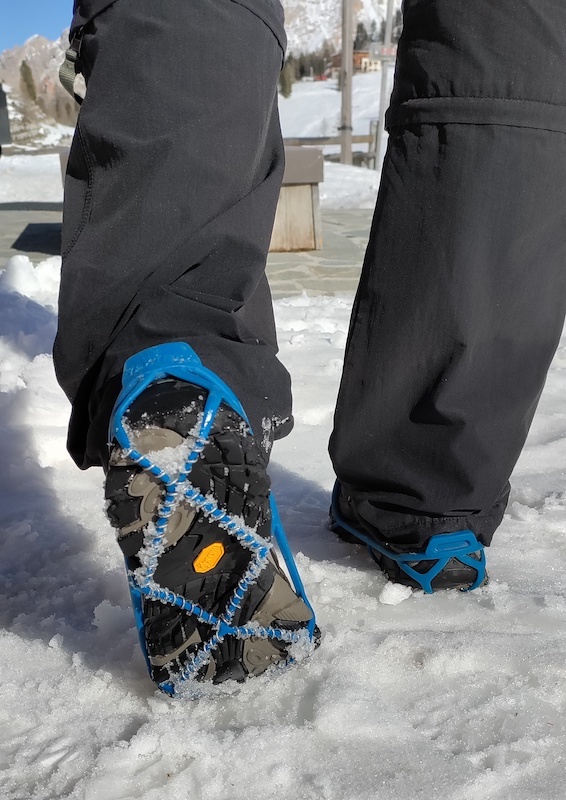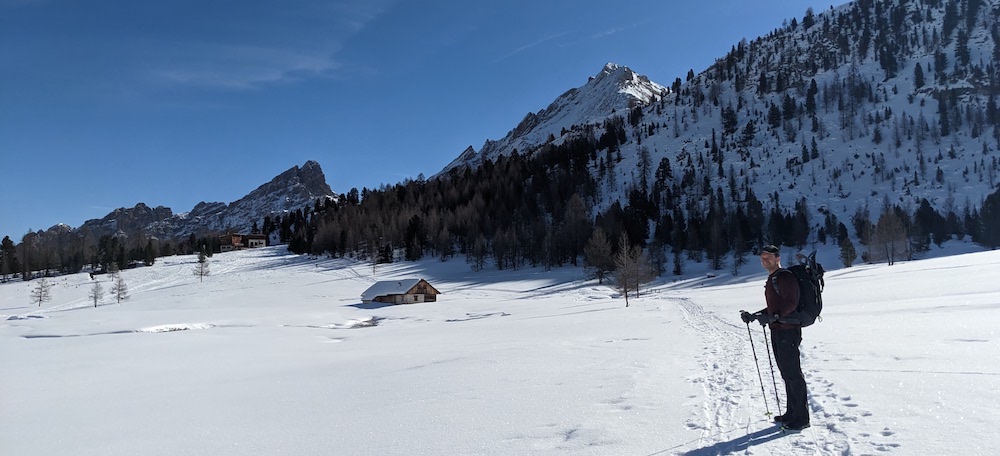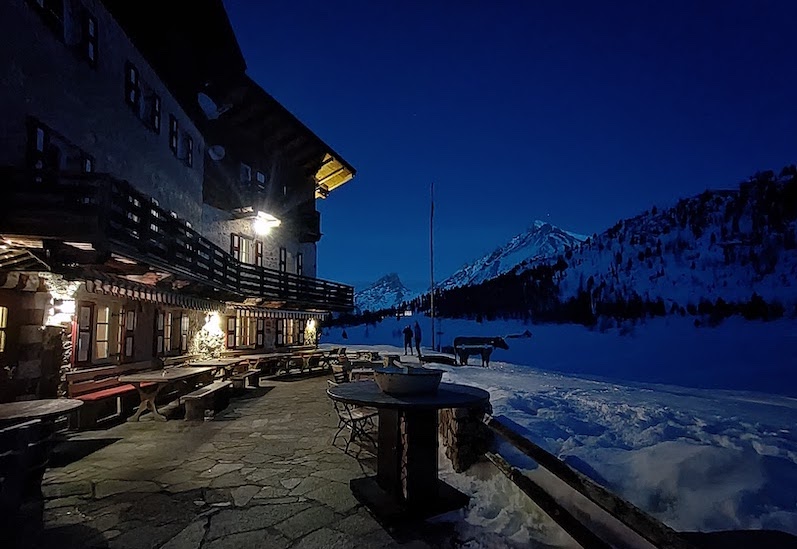After hiking a stunning part of the Dolomites one summer (OK, every part of the Dolomites is stunning, but still…), we decided to return in winter with snowshoes to experience the area in a different season. And, wow — it was like visiting a whole new place — one just as magnificent, but with fewer visitors, more profound silence, and many stars in the beautifully clear (if chilly) night sky. Best of all, the Dolomites are easy to access in all seasons. So what are you waiting for?
Lavarella - home base for the weekend of snowshoeing
Our favorite hut in the Dolomites is Lavarella due to its location, location, and oh yes, location. By that, I mean (1) its serene setting in a scenic alpine meadow surrounded by toothy peaks, (2) the fact that it’s only a 90 minute hike up from the nearest road/car park in Pederü (details below), and (3) the accessibility of the trailhead (3.5 hour drive from Munich, 2 hours from Innsbruck, 3.5 hours from Venice). Lavarella also stands out due to its in-house microbrewery, friendly hosts, and comfortable accommodations — plus the requisite sunny, south-facing terrace. All in all, it’s the perfect home base for exploring the surrounding mountains, whether you’re hiking, snowshoeing, or ski touring.
Note: national parks and nature reserves in Europe are very different to those in North America. They’re neither as wild or remote, and camping is not permitted. On the other hand, we love the charm of huts and the multilingual atmosphere found in them.
Moonlight Hiking in the Dolomites
Winter hiking poses two main challenges: weather (obviously) and shorter daylight hours. The first time we headed to Lavarella in winter, we chose a three-day weekend in order to be able to drive there and hike up to the hut (500m climb over 6km) in daylight on a Friday, so that we could explore locally on Saturday, and hike back down/drive home on Sunday. In doing so, we discovered that in addition to the footpath to the hut, there is also a jeep trail marked by snow poles.
Normally, I’m not a fan of jeep trails in the mountains, but in this case, it’s a bonus, because it means daylight isn’t a limiting factor. So, when we returned for a second visit, we left Munich after work on Friday, drove to the trailhead, and set off in the dark with headlamps, confident that the trail would be easy to follow. It was, with a bonus: the full moon reflected off the snowy landscape so brightly, we didn’t even need our headlamps! In fact, it was a really special experience, and our moon shadows accompanied us the whole way. We still had a full day on Saturday to explore locally, with plenty of time to hike down and drive home on Sunday.
Exploring the mountains in winter
Once at Lavarella (2050m / 6700 feet), you can do as little or as much exploring as you wish over terrain that’s blanketed in a meter (or more) of snow. Trails branch out in several directions, offering multiple choices for day hikes. Of course, in winter, you can strike out in any direction, but you should be mindful not to cause any damage or disturb especially sensitive habitats.
From Lavarella, there are multiple peaks to climb, which is the main draw for ski touring fans. For a stunning day hike, snowshoe to Gran Plan, a broad valley surrounded by jagged mountains (follow signs to Capanna Alpina). There’s a bit of up and down along the way, but long sections of this route are level. It’s very pleasant to head out for about 90 minutes, then stop for a picnic lunch (bring supplies). You’ll have retrace the same route back, but that gives you a chance to take in the views that were originally behind you. Keen explorers can detour along the way, heading up any peak or outlook point that strikes their fancy.
Another good option is leaving the hut and heading up to or toward Antoniusjoch (pass at 2466 meters /8090 feet), with broad views in almost every direction.
Lavarella offers lunch, drinks, and best of all, desserts throughout the day on its sunny terrace. My personal favorite: a sweet, filling Kaiserschmarn (best described as chopped up pancakes with sugar and berries).
Of course, you’re not limited to day hikes. There are other huts in the area, including those we visited in a four day summer trip (described in a separate post, coming soon!): Santa Croce, Lavarella, Scotoni, and Lagazuoi. However, many of the connecting trails cover steep, rocky paths, so for snowshoeing, we were content to stay in the winter wonderland around Lavarella.
Hut practicalities
There are actually two huts close to each other in the same alpine meadow, part of Fanes Sennes Braies Natural Park. One is Lavarella and the other is Rifugio Fanes. Both fill up early, so make sure to reserve well ahead of time. The main point Lavarella scores over Fanes is serving beer from its own microbrewery. Otherwise, both huts are equally comfortable and popular.
Both are private huts, not the slightly more basic, budget huts run by the Italian/Austrian/German Alpine Club. That means Lavarella has extra comforts such as sheets, blankets, and sinks in the rooms, with hot water showers and toilets in shared facilities. A high percentage of the beds at Lavarella are in private double/triple/quad rooms. Those perks come at a price, of course: Lavarella charges €71 for a double, with “Halbpension” (meal plan including dinner and breakfast) required. However, Lavarella also has dormitory beds, which makes for a cheaper alternative.
At Lavarella, dinner served at 18:30, which you’ll miss if you arrive late. However, if you let the hosts know ahead of time, they’ll save you soup and a meat/cheese platter which we found delicious and filling. You can drink water straight from the tap, and there are snacks/picnic lunches available for purchase, in addition to the option of eating in at the restaurant. You can save a bit by carrying in lunch supplies and snacks.
Equipment
Because snow on the jeep trail gets compressed by the hut’s Snowcat, it is possible to reach the hut without snowshoes. However, many people wear them for the reliable grip on snow and ice. We carried our snowshoes and wore hiking boots with quick-mount Taktrax “claws” for traction for the trip to the hut, then used our snowshoes for deep snow at higher altitude and off trails.
- Snowshoes
- Yaktrax
- Poles
- Snacks
- Backpack - my 24L Deuter backpack is big enough for a weekend’s worth of gear, but still compact enough that when I leave most of my gear in the hut for the day, it’s still practical to use as a day pack for local explorations.
- Sunglasses
- Sunscreen
Getting there & resources
The trailhead is at the end of the road at a place called Pederü. For a rough sense of orientation, a driver coming from points north would take the Brenner Highway to the Brixen/Bressanone exit, then head for Brunico/Bruneck, and finally turn off to San Vigilio di Marebbe. From San Vigilio, it’s a final 10km of narrow road to the trailhead at Pederü. This back road should be passable in all but the most severe conditions. Rifugio Pederü at the trailhead is another alternative for late arrivals.
Lavarella and Fanes both offer transportation of people and/or luggage up to the huts in their Snowcats (enclosed van-like vehicles with tracks like a tank). We weren’t interested, but if there had been a blizzard, our Plan B was to swallow our pride for the sake of safety and catch a ride to the hut.
The “where we are” page of the Rifugio Pederü website details how to get to the trailhead by car or pubic transportation, with a weather forecast below that. The Fanes website has a webcam where you can eyeball current conditions. Look up “bus 462 Pederü - St. Vigil” for an up-to-date PDF schedule for a local bus from San Viglio to the trailhead.
Nearby
Lavarella is just one hut of many in the area, and there is much, much more to see and do. It’s also a culturally fascinating place where three languages overlap: Italian, German, and less-known Ladin. Cave bears prowled the area during the Ice Age, leaving traces found not far from Lavarella. As peaceful as the mountains are today, they were the site of fierce fighting in WWI, and you can explore remarkably well-preserved trenches near Lagazuoi, Col di Lana, and Cinque Torri. The area is equally spectacular in summer, with hiking, rock climbing, and more.
Cortina Information
Dolomites Information
I hope this has been helpful and interesting, either as a planning tool or armchair adventure. For other exciting trips and ideas, click on “HOME” at the top of the page. Thank you for visiting TheTravelBug.blog and happy travels!
